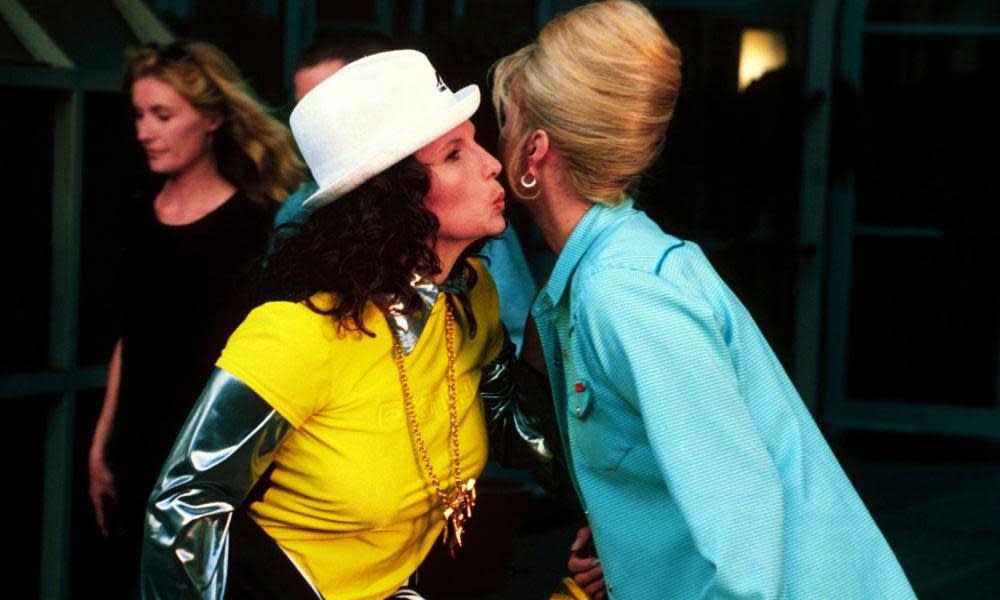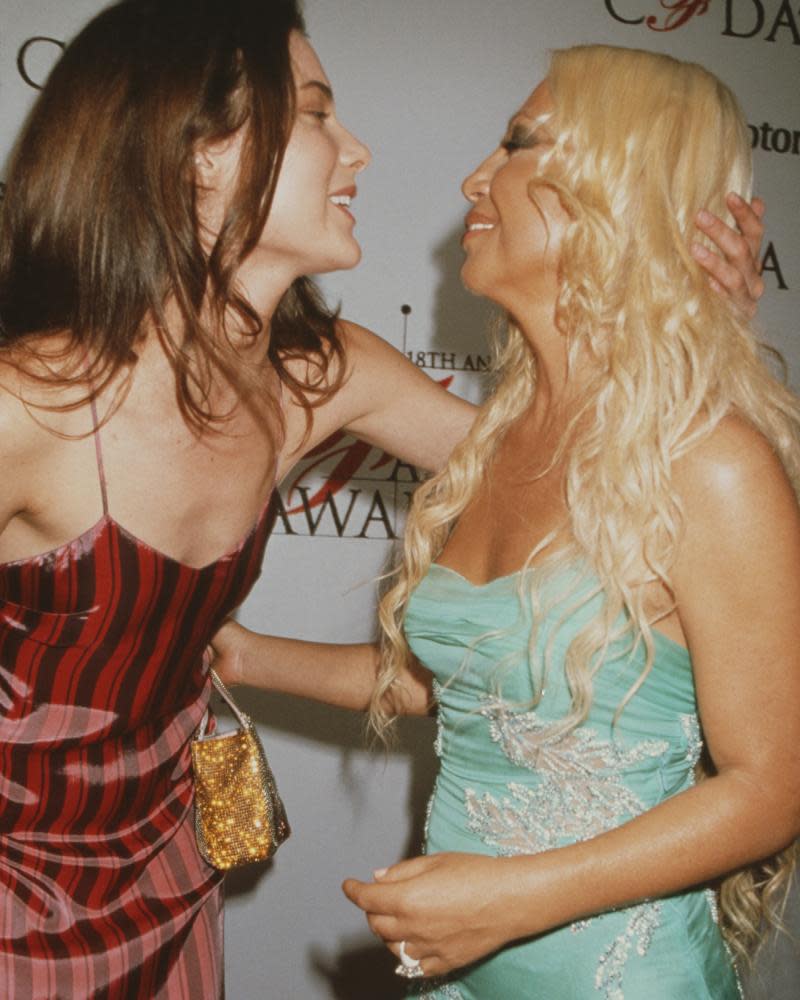So long, sweetie: what next for the air kiss?

Was it horror that flashed through Miuccia Prada’s eyes as I leant towards her with my lips puckered? As she stepped back and offered me her hand, with a Mona Lisa smile, it was clear I had misread the moment. Thankfully, her practised reaction was so smooth that only the two of us, and her hovering bodyguard, appeared to be aware of the micro-debacle.
This is the kind of thing that happens to people like me backstage at fashion shows. People who, shall we say, aren’t exactly a big deal but have to wedge themselves among the great and the good in order to get quotes for news reports.
I have almost air kissed Kanye West, Stella McCartney and Demna Gvasalia, to name just a few. I do not want to smooch famous designers who don’t have a clue who I am, I promise. But when you are captive within a scrum of abundant cheek-peckers, it is all too easy to get stuck on air kissing autopilot.
I worked in the less-coiffed world of features journalism before fashion and it has taken me six years to understand the rules. I now know that true alphas tend to save face-adjacent smooches for people they know, celebrities or people in decision-making roles at luxury conglomerates. Isabella Blow, for example, claimed that fending off kisses “from all and sundry” was the reason she always wore huge hats. Stories of Anna Wintour darting out of range, leaving wannabe air-kissers stumbling, are rife and toe-curling.

At the last physical London fashion week, which opened two weeks after the UK’s first coronavirus case was confirmed, it became clear how ingrained the practice is. People were air kissing while discussing increased hygiene measures and pumping gel from newly installed hand sanitiser stations. The tsunami of “mwahs” did not stop, even as the news worsened and masks were given out at Paris fashion week.
“Are you still air kissing?” I asked one editor, late in February. “Absolutely not,” she said. “If I see someone looming, I tell them to back off.” I was not that brave, however. I was still air kissing, out of reflex, or politeness, despite feeling weird about it, until early March, around the same time that France and Italy banned cheek-pecking and even fashion people finally abandoned it.
For the past five months the issue has been moot, with fashion occupying a strange virtual world of digital couture and Zoom webinars. This week saw the first physical shows since the pandemic began, in Milan, but they were socially distanced affairs. For the foreseeable future, a return to air kissing, as we know it, seems unlikely.
It is often very fleeting, almost on the move, with the giver already checking who else is around
Tony Glenville
This enforced pause - which comes as the fashion industry faces a raft of other significant shifts - feels like the moment to give air kissing a goodbye, or at least au revoir, analysis.
Air kissing is a very strange custom, when you think about it, expressing both closeness and separation. “It is not a ‘real’ kiss,’’ says the fashion historian Tony Glenville. “It is often very fleeting, almost on the move, with the giver already checking who else is around. But people are dreadful at remembering names, so ‘Darling!’ plus a double air kiss, is useful.”
“It is fashion’s equivalent of the masonic handshake,” says Love Magazine’s senior editor Pierre A M’Pelé, “a dramatised version of reality, a proof of acknowledgement and grouping.” It can be useful, he adds, for greeting in a friendly way with boundaries, but, “it can be weaponised, too. Its purposes, depending on how it is performed, can go from real fondness to total disdain.”
Cheek kisses are commonplace in other touchy-feely industries, such as theatre, says the body language expert Judi James, who believes the classic fashion air kiss is different. “It is more about holding people at arm’s length. Both heads are held high. It is more about torso distance than submission.”
A contact-free peck feels counter-intuitive given that human kissing “probably started via mimicry of the parent feeding the child by chewing the food in its own mouth first, like a bird”, says James. Kissing is also thought to have biological functions, such as sniffing out hormones. By removing anything animalistic, the air kiss “takes a signal of attachment and turns it on its head”.
For all its peculiarities, air kissing’s influence has spread. Vogue China’s editor-in-chief, Angelica Cheung, has air kissed her way around fashion weeks for almost 20 years. “In China, and other parts of Asia, such a greeting is generally considered to be a little too informal and overly familiar,” she says. “Having said that, in fashion circles in China, air kissing has become common, but usually when there is an international element to the event.”

I have always assumed fashion’s air kissing tendencies were due to its Parisian roots. That may be where it started, but the absence of lip-to-cheek contact is not very French. “There is not even a French term for ‘air kiss’,” says the fashion academic Agnès Rocamora. Instead, the anthropologist Vaughn M Bryant believes it became popular in around the 1950s. “The purpose is not to mess up a lady’s makeup,” he says. “This is especially true with models and also in Hollywood.”
My sources agree that it became particularly rampant in fashion in the 1980s, which is when Chris Moore, a catwalk photographer of 60 years’ standing, thinks he noticed it. “I call it a fashion kiss,” he says. It is inherently hierarchical, he points out: “It’s a bit difficult to lean over and do a fashion kiss to someone in the second row.”
Sadly something that started off as a lovely gesture has come to be associated with something vacuous and meaningless
Daniel Marks
For the academics Dr Joanne Entwistle and Rocamora, it is a ritual that makes power dynamics visible. In 2006, the pair attended London fashion week for a research paper observing industry customs. “It is a performance of a kiss in an industry dependent on appearances,” says Entwistle. “It’s a flamboyant signal of connection and social capital, its purpose not just for the two people kissing but for anyone who might be watching.”
Unlike, say, a macho slap on the back, the air kiss is clearly the expression of a female-skewed industry. That it took off in the 80s also fits with cliched ideas about women entering the workplace and jostling for supremacy while ricocheting off one another’s shoulderpads. Certainly, the decade’s power-dressing trends – heavy makeup, giant earrings and carapace of lacquered hair – must have made lip-on-cheek contact inadvisable.
If the 80s was peak air kiss, the 90s was when the practice became a cultural phenomenon, thanks to Absolutely Fabulous. The “mwah, mwah, sweetie” catchphrase mined the custom for comedy gold, our heroines delivering it through gritted-teeth to enemies, as often as they did, through a Bolly haze, to each other.
Related: Online fashion weeks offer fresh access — but inclusivity remains an issue
Parodying the air kiss too mercilessly can feel unhelpful when it ties into outdated narratives about female rivalry in the workplace. But questioning customs is important in an industry in which most humans – disabled people, people of colour, working-class people, plus-sized people – have traditionally been excluded. Unwritten rules – weird greeting rituals; a sense that everyone else is firm friends – can form another invisible barrier.
Everyone I spoke to had an air kissing war story. Many in the industry told me they didn’t like the practice at all. “I think sadly something that started off as a lovely gesture of friendship has come to be parodied and associated with something vacuous and meaningless,” says Daniel Marks, the Communication Store’s chief creative officer. The PR Mandi Lennard, more of a handshake woman herself, says: “I think it’s really phoney. I’d hate someone I didn’t know well to regard me as overfamiliar.”
But for all the mishaps and complaints, it took a pandemic for fashion people to stop doing it. And here’s a concerning thought: some I spoke to had seen the odd clandestine air kiss happening again, already. In fact, air kissing is not the most perilous greeting for socially distanced times. The University of Hong Kong’s Yuguo Li says, if you are at least 1.5m apart, with no contact at all, the risk is low; Dr Julian Tang, a respiratory sciences professor at the University of Leicester, adds that the risks are further reduced outside. I worry that this is all the encouragement some – and then, inevitably, me – will need to start air kissing at great distance, introducing even more absurdity.
In any case, its spirit lives on on social media, a business that monetises status anxiety and encourages users to make “content” out of their connections. On Instagram, you can display proximity to power by screenshotting a Zoom meeting, or perform closeness by posting an in-joke underneath a contact’s post. Or, if you don’t know them well enough for an in-joke, a handful of emojis will do. As M’Pele says: “The kissing emoji – the one without the heart – is the new air kiss.”


